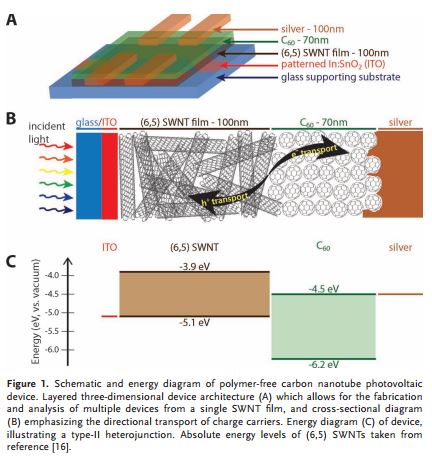Both cost and performance requirements make semiconducting single-walled carbon nanotubes (SWNT) attractive as photo-absorbers for near-infrared photovoltaic (nIR PV) applications. Their solution-process-ability (which can substantially reduce manufacturing costs), earth-abundant source materials, and recently scale-able fabrication and purification may yield low cost manufacture, a limitation with conventional solar cell (SC) designs. Furthermore, such devices can augment the photo-conversion efficiencies of conventional visible-PV systems by absorbing nIR wavelengths that comprise approximately 22% of the solar spectrum but fall within a typical PV bandgap. Here, low unit-operations costs particularly enable this application by making stacked independent PV layers (four-terminal SCs) feasible, versus the constraints of one-step fabrication (i.e. lattice, bandgap, and workfunction matching constraints) that have challenged tandem multi-junction (two-terminal) SCs. SWNT are also attractive relative to many other organic and inorganic PV materials through exceptional exciton and free carrier diffusivity and mobility, exceptional absorption cross-sections, and resistance to oxidation by water and oxygen. To date, single-walled nanotube (SWNT) SCs with 0.01-1.7% external quantum efficiency (EQE) have been developed employing single chiralities, mixed semiconducting chiralities, and mixed semiconducting and metal chiralities in bulk heterojunction and planar heterojunction1, configurations using polymers and fullerenes for exciton dissociation and/or co-photoabsorption.
We advance this technology in two parallel work streams. Experimentally, we have exploited our ability to refine high quantities of high purity single-chirality material to fabricate the first all-carbon photovoltaics. Because of the huge space of design variables (nanotube alignment, orientaiton, length, chirality, defect type and level, device thickness, etc.) however, it is difficult to clearly identify the path to performance improvement. To that end, we also have a theoretical effort, where we have derived a deterministic model of steady-state SWNT photovoltaic operation directly from fundamental SWNT photophysics. That work has revealed what parameters and morphologies are necessary to achieve order-of-magnitude performance improvements, while our experimental capabilities will allow us to apply those theories and realize technological development.

References:
DO Bellisario, RM Jain, Z Ulissi, MS Strano. Deterministic modelling of carbon nanotube near-infrared solar cells. Energy & Environ. Sci. 2014,7, 3769-3781
http://doi.org/10.1039/
RM Jain, R Howden, MS Strano, et al. Polymer-Free Near-Infrared Photovoltaics with Single Chirality (6,5) Semiconducting Carbon Nanotube Active Layers. Adv. Mat. 2012, 24, 32, 4436–4439
http://doi.org/10.1002/adma.